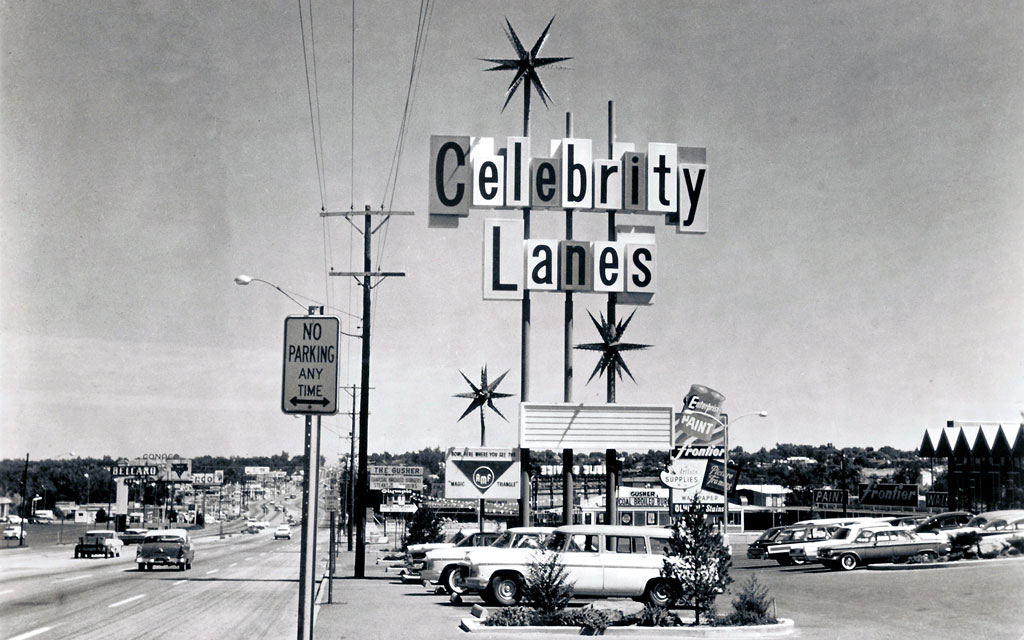
Celebrity Sports Center, looking north on Colorado Boulevard
B50 Note: Everything you ever wanted to know about Celebrity Sports Center. No, really. This article was originally published in Colorado Heritage magazine in Autumn 2007. Reprinted with permission of the Author. Images courtesy of celebrity.bt76.com
Spares and Splashes: Walt Disney’s Celebrity Sports Center
— by David Forsyth
Once, when speaking about the entertainment empire he had built, Walt Disney said, “I only hope that we never lose sight of one thing—that it was all started by a mouse.” Over the forty years that Disney oversaw his creations, they expanded from simple cartoons to enormously popular movies and theme parks. Although his enterprises were huge successes, Disney never let that success slow him down because, as he said once, “I can never stand still. I must explore and experiment.” That desire for exploration, with the financial backing of the mouse, brought Disney to Colorado on several occasions, and it led him to launch one of his company’s major experiments in Denver.

The Celebrity Sign at Night
When Lakeside opened in 1908, the Denver Republican praised the summer resort as a welcome addition to Denver’s recreation needs. Nature, the Republican wrote on May 24, 1908, had done a good job of supplying Denver with winter amusements, but the city had never had “an open air playground in keeping with the demands of its cosmopolitan and thoroughly discriminating population.” By 1959 the exact opposite attitude seemed true—Denver was sorely in need of amusement options for the winter, or at least options that were impervious to bad weather. In late 1959 a group of investors joined forces on a project that could offer hours of amusement regardless of the weather while also improving the lives of the area’s young people—a priority for one of the investors.
On November 15, 1959, The Denver Post announced that a “huge play center” was in the works for southeast Denver. According to the Post, the center was to include an eighty-lane bowling alley, a massive indoor swimming pool, restaurants, a lounge, and a health salon. The center would be owned and operated by Celebrity Bowling, Inc., a recently formed corporation based in Los Angeles.
While none of these activities were especially original, what was unique about the future Celebrity Sports Center was its ownership. The facility took its name from the fact that it was owned by a number of Hollywood celebrities, among them Jack Benny, George Burns and Gracie Allen, Burl Ives, Bing Crosby, Spike Jones, Art Linkletter, and John Payne. And there was one other major investor, whom visitors sometimes encountered at the site once construction got under way—Walt Disney.
I cannot read the gallery's xml file: /home/12842/domains/buckfifty.org/html/images/celebrity/gallery.xml
Please check that the gallery's files have been created on the admin pages!
According to Walt Disney’s daughter Diane Disney Miller, it was her father’s lawyer, Lloyd Wright, Sr., who first approached him with the idea for the bowling alley project. Disney did not seek out investments like Celebrity on his own because, according to his daughter, he was “wholly concerned with his own projects.” But for Wright’s sake, he decided to invest in the new venture. In addition to attracting other famous investors to it, Disney brought nearly his entire family in on the deal. He convinced his daughter Diane and her husband, Ron, his brother Roy O., and his nephew Roy E. and his wife all to put money into Celebrity.
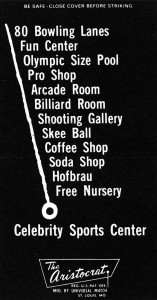
A Celebrity Matchbook
The Denver Post reported on December 13, 1959, that a group of the celebrity investors was set to arrive in Denver the next day for official groundbreaking ceremonies for the 122,600-square-foot facility. The newspaper also revealed more detailed plans for what the center, designed by the architectural firm of Powers, Daly, DeRoss of Long Beach, California, was to include. The bowling equipment, which cost $1,250,000 alone, was also “the largest single order for such equipment in U.S. history.” The bowling alley, as planned, would be capable of seating at least 2,000 people at the major bowling tournaments the owners expected to attract. The 165-foot-long swimming pool was to be housed in a building with a removable skylight and a retractable glass wall that allowed access to a patio for sunbathing and other activities. The parking garage, together with outdoor parking, was to provide space for 700 cars. Plans also called for the construction of the $1.25 million Aqua Bowl Motel across Colorado Boulevard from Celebrity, but for reasons known only to the investors, the motel was never built.
Lloyd Wright told the Post that Celebrity Lanes would be the first of many such projects that he and the other investors would open around the country, but like the motel, those other projects never materialized. Walt Disney, also speaking to Post reporters, “hailed the project as a ‘new dimension to family participation in sports and recreation.’” He went on to say that it was “only fitting” that the project should be built in Denver, as it was one of the fastest growing cities in the country.
At 11:10 A.M. on Monday, December 14, 1959, Continental Golden Jet 707 carrying Disney, Spike Jones, Jack Benny, John Payne, Lloyd Wright, and Richard Fletcher, the newly named general manager of the yet-to-be-built facility, landed at Stapleton Airport. The group was met by several local officials and the “Pink Poodle Posse” girls of Denver, making for a high-profile reception. They proceeded by motorcade to the construction site on Colorado Boulevard, where work had already begun, for the official groundbreaking. They were joined there by Governor Steve McNichols. After a brief ceremony, in which each of the seven men took shovels and officially broke ground, the group went to the Brown Palace Hotel for a luncheon and press conference.

The Celebrities
Disney went on to stress, as he had before, that he and the other investors chose Denver because it was one of the fastest growing metropolitan areas in the country. Although the owners considered a number of other cities as sites for Celebrity Lanes, months of research led them to select Denver for that reason. While Celebrity would primarily serve the recreational needs of the growing population, the owners had other goals for it as well. Disney and his fellow investors hoped to attract national bowling and swimming events to the center, and, in order to accommodate these, the plans for the building included all the equipment necessary for coast-to-coast television broadcasts. The Post reported that, with construction then under way on Celebrity, the sport of bowling had stolen “a march on other major sports . . . in the Mile High area.”
After the famous investors clowned some more for the reporters—at one point posing for a photo in which Spike Jones used a fireplace poker to play a bowling pin like a violin while Jack Benny played the piano and Disney sang—they left Denver at 6 P.M. Construction at Celebrity moved forward quickly under the direction of Denverites Keith Talley (who owned his own construction company), Donald Rudolph of Donald’s Self Service Drive Inns, and L. D. Stackhouse of Stackhouse Construction. Opening day was set for sometime in June or July 1960, “depending on the weather.”
The first of thirty-five semi-trailers carrying the bowling equipment for Celebrity arrived at the construction site in mid-June 1960. According to The Denver Post, the “bowling showplace” would be the focal point of Celebrity Lanes, so workers were taking great care in building it. The semi-trailers that arrived throughout June carried fifty-eight miles of lumber for the lanes, two-and-a-half tons of nails, 15,000 wood screws, and 350 gallons of a special lacquer produced by American Machine and Foundry for the bowling lanes. Work was also progressing on other parts of the center, including the lounge and restaurant. These were designed with a “motif of Colorado field rock with indoor waterfalls and fireplace.” While these other projects did require some attention from the workers, their primary goal was to finish the bowling alley, which they were rushing to complete. According to the Post, “with construction proceeding on schedule,” the bowling alley was set to open in August, suggesting that the weather may indeed have delayed construction a bit.
The time was right for such a project for reasons other than Denver’s impressive population growth. Considered a rich man’s sport in the seventeenth and eighteenth centuries, bowling had declined in popularity over the years to the point that it was considered “a marginal sport limited to sleazy venues,” as LeRoy Ashby writes. But that perception started to change in the 1940s and ‘50s. A careful marketing program that stressed new automatic pinsetters and air-conditioned buildings that were becoming standard succeeded in making bowling an attractive family activity. Bowling gained so much popularity that Life magazine described it as the country’s most popular sport—for some, even a way of life. By the mid-1950s there were more than 20 million regular bowlers in the United States.
Bowling at Celebrity Lanes proved to be a very popular attraction in Denver, even before the bowling alley opened. Richard Fletcher announced in June 1960, as the first trailers full of bowling equipment arrived, that night leagues at the bowling alley were about 80-percent full. League schedules for earlier in the day from Monday through Friday were completely filled, two months before the bowling alley even opened. Business was certainly off to a good start.Completed at the same time as the bowling alley were the arcade and the massive slot-car tracks, located in the basement underneath the arcade. Game rooms such as the one at Celebrity grew out of the penny arcades and nickelodeons of the 1890s and early 1900s, both of which could be found at Disneyland when it opened. Arcades were popular hangouts for teenage boys especially, and Celebrity offered a shooting gallery and several pinball games for them to play. When video games became more common in the 1970s they started appearing in the arcade as well. Celebrity promoted the slot-car tracks in its basement as the longest such tracks known to exist, the racing area covering a total of 13,500 square feet. The shortest track was 200 feet long while the longest, known as “Tubby,” was 250 feet long. The room housing the tracks was carpeted in red and gold. The slot-car tracks at Celebrity remained a popular draw for many years.
The bowling alley was in business for nearly a year before the swimming pool, at first called “Olympic Swim,” finally opened in July 1961. The timing was also right for it, as the 1960s saw a boom in pool construction throughout the country. At 164 feet one inch long by seventy-five feet one inch wide, the pool was Colorado’s biggest. The extra inch in both length and width was meant to accommodate any possible pool contraction, guaranteeing that any swimming records set at Celebrity would merit international recognition. The pool, quickly nicknamed “the swamp” by Celebrity employees, held 500,000 gallons of “constantly filtered and heated water,” had five diving boards, and boasted nine swimming lanes instead of the usual eight. The pool was housed in a 32,000-square-foot building with indoor locker rooms, a floating snack patio, and spectator stands. The originally planned removable skylight and retractable glass wall were dropped from the final plans for the building. Tom Murphy, director of the pool and swimming coach at the University of Denver, signed on as pool director at Celebrity the same month the pool opened. Admission in 1961 was one dollar for children under sixteen and $1.50 for adults. Swimming suits and towels were available for rental.
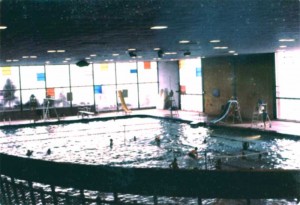
The Celebrity Pool
The opening of the swimming pool marked the completion of the $6 million Celebrity Lanes as called for in the original plans. The addition of Tom Murphy as pool director completed the management team at Celebrity. At the beginning of May 1961 the owners had hired retired general Eugene Mussett, the commander of Lowry Air Force Base from 1956 to 1960, as vice president of operations. This freed Richard Fletcher to focus solely on recreational activities at Celebrity, which was what he had wanted to do all along. He was assisted in this job by Spike Cleysens and Jasper Perry. Frank Shumway oversaw food operations, which, in addition to the lounge and restaurant, included a Hofbrau room where diners enjoyed beer and sandwiches along with a soda bar for the children.
In the years following the opening of the swimming pool the recreational activities at Celebrity continued to expand as new and different phases of the project were added and completed. One of the major, and most popular, additions was an expanded video-game arcade. Eventually three arcades housed a total of 300 games for children and adults. The billiard rooms—a late addition to the original plans—were another popular attraction at Celebrity. Subsequent owners added three water slides to the pool around 1980. The lowest of the slides, the Dolphin, was meant for small children. The next up was the Barracuda. In the opinion of most people, though, the best slide was the highest—the Shark—even though it required going up six concrete ramps in bare feet in order to go down it. Drivers passing by on Colorado Boulevard were often greeted by the familiar sight of children and adults careening down the slides.
The pool was so big and so popular that it hosted a number of special events over the years. In the 1970s the center began holding an annual Hobie Sailing Regatta in the pool, where forty-eight teams of three members each raced six ten-foot sailboats around the pool with wind provided by “large, strategically placed fans.” Hobie Alter, creator of Hobie Sailboats, Catamarans, and Surfboards, was on hand for the 1977 race in order to award the prizes to the winning teams, the top two being a sixteen-foot Hobie sailboat for first place and a ten-foot version for second. Altogether the teams, made up of employees from Denver-area restaurants, competed for $4,000 in prizes.
All of these activities made Celebrity such a crowd-pleaser that it drew its share of well-known visitors from Colorado and around the country. Boxer Sonny Liston trained for at least one of his matches in the swimming pool. Minnesota Fats and Willie Mosconi each shot pool in Celebrity’s billiard rooms, and baseball star Billy Martin “entertained cronies” in the Captain’s Tavern, another of the center’s restaurants. Over the years famous Coloradans, including Denver Bronco quarterback John Elway, Bronco coach Dan Reeves, Denver Nugget Dikembe Mutombo, Governor Dick Lamm, U.S. Representative Pat Schroeder, and Denver Mayor Federico Peña, were all spotted bowling at Celebrity. But Celebrity Lanes, with all of its celebrity connections, was not merely a “place for the well-to-do.” The pool, wrote the Rocky Mountain News, was “a serious place to swim for people who couldn’t afford the country clubs,” and they came in droves. Even as Celebrity began its decline in the 1980s and early ‘90s, it still drew nearly a million visitors a year.
Among Celebrity’s high-profile owners and visitors, there was one personality whose visits outshone all others. At the time that he started planning Celebrity’s construction, Walt Disney already had a long-standing interest in Colorado. After vacationing in the state in 1956 he flew back to California “laden with books on Colorado’s history,” which he intended to mine for story ideas. He even bought a petrified tree stump from the Florissant Fossil Beds (it was legal to buy them before the area became a national monument in 1969); he installed the stump in Frontierland at Disneyland. Throughout his life he and his family vacationed in the state to go horseback riding or skiing. Disney was so fond of his visits to Colorado that he once told reporters he wanted to find a place to rent or buy, but it never happened.
After Celebrity opened, Disney was a frequent visitor there as well, whether for anniversary celebrations, dedications, or simple inspection tours. A reporter for the Rocky Mountain News wrote that “although Celebrity Center is a small part of the Disney enterprises it received a large share of attention.” When he arrived at Celebrity on one of his visits, Disney usually stopped first to take a look at the books to make sure things were going well financially. Then, he would walk through the “complex of bowling alleys, recreation rooms, restaurants asking questions about everything.”
As in his other business ventures, Disney was mindful of the details at Celebrity, even the smallest ones. He was so concerned that things be just right that he even assigned an art director who had worked on Disneyland to oversee new developments at the center in order to guarantee that everything was to his liking. As Disney executive Robert Allen said in 1966, “practically everything at the center . . . bears the mark of Disney’s personal touch.” On these visits Disney did find time for some fun, such as the occasional bowling game.
One of Walt Disney’s most elaborate visits to Celebrity was in September 1962 when he came to help celebrate the second anniversary of the center and to dedicate the new Stouffer’s Restaurant, which was about to open. When he arrived in Denver he was accompanied by Vernon Stouffer, Hayley Mills, Annette Funicello, Mickey Mouse, and Pluto, among others. As part of the activities surrounding the opening of the restaurant, the group held a press conference for Denver-area high school newspaper reporters and attended a reception at the governor’s mansion. When they finally got around to dedicating the restaurant, Denver financier Aksel Nielsen introduced Disney at the ceremony.
At a press conference for Denver reporters on September 14, 1962, the day before the restaurant’s dedication, Disney said that he hoped Celebrity would continue to be a place where children could develop an interest in sporting activities. Demonstrating his long-standing concern with social issues of the day, Disney said he thought this particularly important as child labor laws, “too stringent in many instances,” were preventing children from having enough to do, making it very important for them to develop an interest in sports or other activities. Disney also spoke on more lighthearted subjects, including why he had a moustache (to cover a childhood baseball injury that split his upper lip and knocked out two teeth) and his desire to make a movie based on the “Little Britches” stories by Colorado author Ralph Moody.
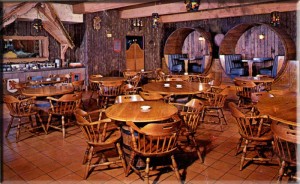
The Hofbrau
Plenty of visitors, from the famous to the not-so-famous, had fun at Celebrity during its first years, but management was not having quite as good a time. Both Diane Disney Miller and Roy E. Disney remember management problems as being one of the major difficulties plaguing Celebrity Lanes from the beginning. As one indication of the problems the business faced, General Mussett resigned as vice president of operations in October 1961, just six months after taking the position. Mussett said he was “not at liberty” to comment any further on the subject and quickly devoted himself to his new position as president of a fallout shelter manufacturer. Still, Mussett’s son Gerry remembered his father’s short tenure at Celebrity as “good times.”
The management situation at Celebrity grew so unstable by 1962 that, according to Diane Disney Miller, the other celebrated investors simply “wanted out.” According to Walt Disney Company archivist Dave Smith, in addition to the management problems, the investment had proved disappointing financially to them. In order to solve the problem Walt Disney arranged to have his company buy out the other investors. Disney began the process in October 1961, at the same time that General Mussett resigned as vice president of operations. By 1962 Walt Disney Productions was the sole owner of Celebrity Lanes. One of the company’s first moves was to rename it “Celebrity Sports Center,” a reflection of the “expanded facilities” the restaurants and pool provided.
While Walt Disney and his company were committed to ensuring Celebrity’s “continuing acceptance by the residents of the Denver area,” they were also coming up with other plans for the facility. At about this same time Disney was in the early stages of planning for his most ambitious project—what would become Walt Disney World in Florida. Celebrity Sports Center would play an important role in the plans for Walt Disney’s new project.
Long before Disney made his comments at the 1962 press conference in Denver about children’s need for an interest in sports, he demonstrated a concern about many other problems he felt were plaguing the world. Disneyland Park was, in part, his first attempt at addressing some of these issues. At Disneyland, visitors could come to a clean, crime-free environment that allowed them to experience the past in Main Street, U.S.A., and the future in Tomorrowland. Above all, Disneyland, the happiest place on earth, was where a person could “leave Today, with its care and worries, behind and enter a world of Yesterday, Tomorrow and Fantasy.” While not as elaborate as Disneyland, Celebrity was largely designed to accomplish the same thing. The public swimming pool construction boom of the 1960s was meant to deal with the social problems Disney picked up on, such as crime and juvenile delinquency, by giving “idle youths” something positive to do in the summer. The one advantage Celebrity had over many of these swimming pools was that it was open year round.
The people who worked at Celebrity were key to the experience Walt Disney was trying to provide. At Disneyland he constantly went on inspection tours of the park, noticing even the smallest details, just as he did at Celebrity. On one visit to Disneyland he noticed a man working on the train who was rude in the way he handled customers. Disney urged another employee to give the man “a better understanding of the business we’re in… We’re selling happiness.”
Disney also had strict regulations about his employees’ appearance. The 1955 and 1962 employee handbooks made it clear that visitors were to be treated like guests, and the staff were to think of themselves as actors and actresses who were there to serve them. Men were to have short hair and shined shoes, and women were not allowed to wear jewelry or heavy perfume. In the summer of 1965 more than 500 teenagers looking for jobs at Disneyland were turned away because they were wearing shorts, and had beards or long hair. Disney even started Disney University, a training school for park employees, in order to ensure that they understood what he expected.Employees at Celebrity were expected to follow the same rules. Celebrity staff watched a training film starring Walt Disney, in which he explained his expectations. Management continued to use the film even after his death, for as long as the Disney Company owned Celebrity. While the rules were strict, there were exceptions for certain workers. Pool employees were the only staff at Celebrity during the Disney years who were allowed to shout at customers. This one exception was due, largely, to the fact that the pool’s one-dollar admission charge made it an inexpensive place for parents to leave their sometimes unruly children all day during summer vacations. In all other areas of Celebrity, employees were expected to treat visitors as guests, just as they did at the Disney theme parks.
Being a Disney employee at Celebrity had its benefits. As long as the swimming pool or bowling lanes were not full, employees and members of their family were allowed to use the facilities free of charge. Celebrity workers were also eligible to join the Magic Kingdom Club for free. The club had originated as a way to attract industrial and government employees to Disneyland by offering reduced price tickets, but it was soon expanded to include a number of other groups, including Disney employees. As members of the club, employees could buy tickets to Disneyland and, later, Walt Disney World at reduced prices from special ticket booths at both parks. They also enjoyed discounts on car rentals and hotel rooms in California and Florida. Permanent Disney employees at Celebrity were eligible for free tickets to Disneyland and Walt Disney World after one year of employment.
 The management workforce at Celebrity was especially held to those same standards, if not higher ones, because many of them were being trained for management positions at what would become Disney World. Walt Disney started exploring the idea of building a Disneyland somewhere on the East Coast in 1959, going so far as to hire a research firm to investigate whether or not the idea was feasible. Disney’s four exhibits (“it’s a small world,” the Carousel of Progress, an audio-animatronics Abraham Lincoln, and a dinosaur diorama) at the 1964 World’s Fair in New York were partly designed to test whether or not an eastern audience would accept Disney-style entertainment. The fact that all four were successful helped convince Disney to go forward with the project, and he and his brother Roy quietly started buying up as much land in Florida as they could. While plans for what would become Walt Disney World Resort included a theme park like the one in California, Walt’s passion was for “EPCOT,” the Experimental Prototype Community of Tomorrow.
The management workforce at Celebrity was especially held to those same standards, if not higher ones, because many of them were being trained for management positions at what would become Disney World. Walt Disney started exploring the idea of building a Disneyland somewhere on the East Coast in 1959, going so far as to hire a research firm to investigate whether or not the idea was feasible. Disney’s four exhibits (“it’s a small world,” the Carousel of Progress, an audio-animatronics Abraham Lincoln, and a dinosaur diorama) at the 1964 World’s Fair in New York were partly designed to test whether or not an eastern audience would accept Disney-style entertainment. The fact that all four were successful helped convince Disney to go forward with the project, and he and his brother Roy quietly started buying up as much land in Florida as they could. While plans for what would become Walt Disney World Resort included a theme park like the one in California, Walt’s passion was for “EPCOT,” the Experimental Prototype Community of Tomorrow.
As he outlined it in his last filmed appearance in 1966, EPCOT would be laid out like a wheel, with a thirty-acre, glass-domed, air-conditioned hub offering a thirty-story hotel and convention center, stores, offices, and restaurants. Mass transit would be the main form of transportation, with roads for cars and trucks buried underground. Outside the dome would be residential and greenbelt areas. EPCOT would be a self-contained city that could control its climate, recycle waste, and feed its own citizens. It would be a “showcase for American industry and research, schools, cultural and education opportunities.” There would be no crime, no slum areas, and if at all possible, no disease, hunger, or want. With EPCOT, Walt Disney was providing the ultimate answer to the social problems he had confronted with projects such as Disneyland and Celebrity.
With planning for Walt Disney World under way, Celebrity Sports Center took on a new role as a training ground for future management of the Florida park. The center trained people at managing a family resort in order to guarantee a pool of experienced staff when Walt Disney World opened. The only experience they did not gain at Celebrity was in hotel management, which would be a crucial part of Walt Disney World. Company executives solved that problem by leasing a Hilton hotel in Florida and then turning over management of it to Disney staff until Disney’s Contemporary Hotel at the resort was nearing completion. A number of notable Disney executives had their first managerial experience at Celebrity, including Bob Allen, who was credited with making Celebrity a financial success; David Jaskiewicz, who retired as vice president of human resources at Walt Disney World Resort in 2001; and Ralph Kent, a Walt Disney “Imagineer.”
Walt Disney’s death on December 15, 1966, put an end to his direct influence at Celebrity, but the company continued to operate Celebrity as a training ground for future Walt Disney World employees for the next thirteen years.
The Disney era at Celebrity came to an end in 1979. Ron Cayo, vice president of business affairs for The Walt Disney Company at the time, told the Rocky Mountain Journal that Celebrity was something that had never “fit into our overall operation,” though it had been financially successful. The company decided to sell the property.
The first attempt at a sale came in the summer of 1978, when the Disney company was negotiating with a group of buyers who had arranged financing for the deal through Mountain Banks, Ltd., a company controlled by Texan Neil Griffin. Mountain Banks owned eight banks, one of which was Cherry Creek National. That deal fell through because the amount of publicity it generated scared off the buyers. But Griffin and Bob Leavitt, the chief operating officer and president of Mountain Banks, decided that they themselves were interested in buying Celebrity. According to Griffin, Celebrity in 1979 was still a profitable enterprise and they felt that better management and some structural and attraction improvements would only make it more so.
Griffin and Leavitt learned that Colorado real estate developers Russell and Dirck Writer were also interested in buying Celebrity. Griffin knew the Writers, and so the four men joined forces to buy the business. The deal was completed on March 29, 1979, as The Walt Disney Company sold Celebrity Sports Center to Griffin, Leavitt, and the Writer brothers for an undisclosed price. After nineteen years, Mickey Mouse and his friends were gone from Denver.
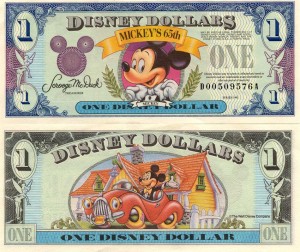
mickey money
Throughout the early 1980s Celebrity remained enormously popular. This was especially true of the arcade, which the Writers, Griffin, and Leavitt expanded and improved. The arcade earned such a reputation, in fact, that it was chosen in 1984 to host the debut of the then cutting-edge video game “Space Age,” produced by Magicom as a sequel to its very popular “Dragon’s Lair” game. The game, which included twenty-five minutes of animation, was designed by Don Bluth, who was himself a former Disney animator. In it players had to help the superhero, Dexter, fight the Infanto Ray of the evil Borf, alien plants, and “free floating guardians” of a speed tunnel. Bluth told a Rocky Mountain News reporter that he chose to launch the game at Celebrity in large part because of the number of families who played there. The game’s debut was such a big event that the News even sponsored a tournament at Celebrity at the beginning of March 1984.
The bowling alleys also thrived through the 1970s and 1980s as schools and bowling leagues from the around the state held games and championship tournaments there. One of the biggest was the 1976 Women’s International Bowling Congress annual tournament, with more than 9,200 teams competing. In 1978 the Japanese American National Bowling Association held its tournament at Celebrity, only the fourth since the association had broken away from the Japanese American Citizens League in 1974. The tournament drew an “outstanding turnout.” The pool, as always, was also a popular attraction, especially after the addition of the three water slides.
Their investment in Celebrity proved profitable to the new owners, but by the mid-1980s the Writers found themselves running into a number of financial problems. One of the worst was having to return their Riverfront Shopping Center development in Littleton to the backers who had put up the money for it. Money issues left the Writers unable to meet their financial obligations to Celebrity, so Griffin and Leavitt bought out their share of it. Another problem Celebrity faced was the increasing commercial development going on around it. The Celebrity property became more and more attractive to commercial developers—not a good omen for the survival of the center.
While millions of people still had fun there, by the late 1980s Celebrity Sports Center was beginning to decline. In addition to the ever-increasing interest in the land from retail stores, many people were starting to perceive Celebrity, which had been in part designed to combat social problems, as a social problem in itself. The city of Glendale, especially its police department, was particularly troubled by the center’s apparent attractiveness to troublemakers.
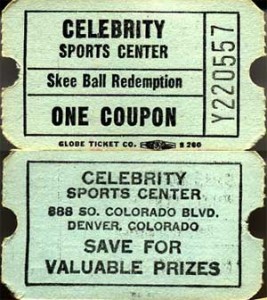
skeeball coupon
Celebrity Sports Center closed its doors for the last time at midnight on June 15, 1994. When Griffin and Leavitt announced the center’s eventual demise they also stated that they hoped someone might buy the pieces of it, especially the bowling lanes and other equipment. At least part of this wish was realized as the wood from the bowling lanes found new life as the floor of the ballroom at the Oxford Hotel in Denver and one of the stars from the famous sign wound up at the Lumber Baron Inn in Denver.
The wrecking ball finally came in March 1995. The first thing to fall was the famous two-story “Celebrity Fun Center” sign, which went “crashing to the asphalt.” Next, the wrecking machine took a chunk from one of the swimming pool’s three water slides. A week after the sign fell, the demolition crew set up a diesel-powered crusher that was capable of processing 200 tons of asphalt and concrete an hour. Less than a month later, nothing remained of Celebrity Sports Center, Walt Disney’s only Colorado business venture.
Construction quickly changed the area that once housed Celebrity, making it nearly impossible to even recognize where the building once stood. In the fall of 1995 the Builder’s Square opened at the new shopping area, named the “Celebrity Center” in honor of its past.
In its thirty-five-year history Celebrity Sports Center served as a sign of its times, from the renewed popularity of bowling, the rise of public swimming, the creation of video-game arcades, and even the economic redevelopment that brought about its demise. And even though Celebrity is gone, it is still fondly remembered by the people who owned it, the Disney employees who worked there, and the many who played there as children and adults.
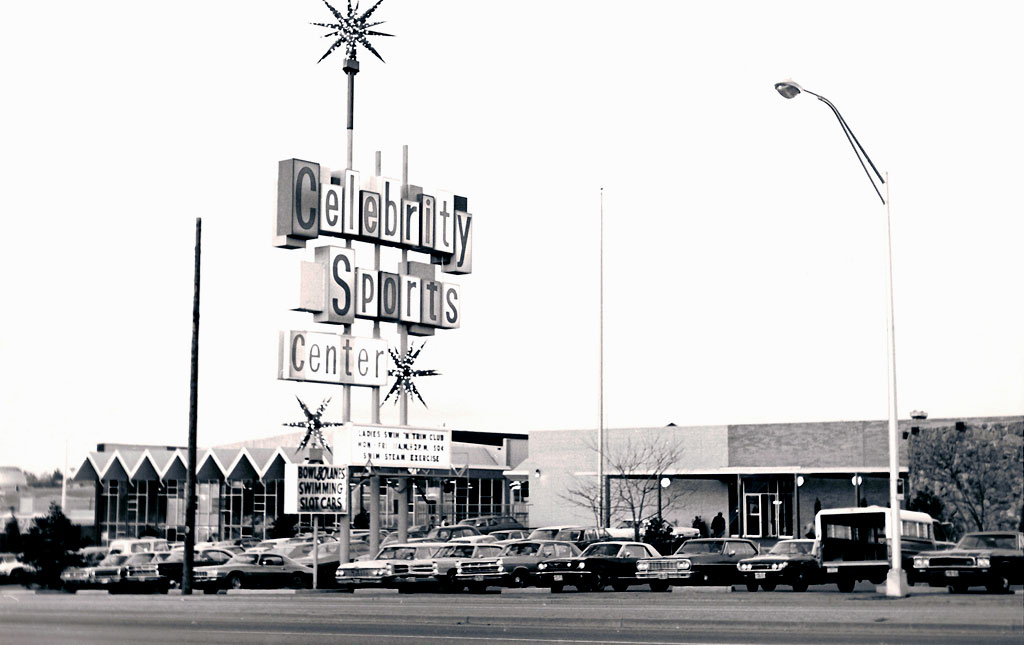
Celebrity from Colorado Boulevard

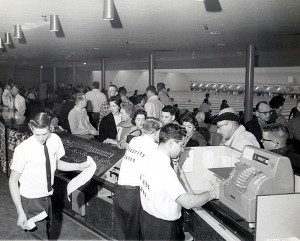

I worked at Celebrity in 1968 while attending computer programming school. I also bowled in a league one night a week. Celebrity Sports Center was a great place to work, and I met many great friends while working in the Hofbrau. I was sorry to hear they tore it down. I know many parents who would drop off their kids on Saturday mornings, give them money for swimming, eating, bowling, etc.; then pick them up around 5:00 pm. Celebrity could be a “cheap” baby sitter. :-)
Ahhh the nostalgia… I was only 8yrs old when this closed but even to this day I still miss this place. The memories are irreplaceable, I remember the pool the most becaue I’ve always loved being in the water and everything about that places was good vibes and good times, after all what else could you ask for from a family entertainment establishment!!! I wish this place was still around or even something similar. Those of you who have shared your memories, thank you… it’s truly amazing to see how this awesome place affected so many lives and hearts.
Does anyone remember the names of the slot car tracks? I’m thinking there was a big red one named Daytona and one named Sebring but I’m not really that clear on it. It was a blast for hot summer afternoons.
Spent Prom Night 1969 (Alameda) at Celebrity Sports Center and had a blast!!! Safe but fun and made a lifetime memory. Never knew Disney was the guy behind all of it and I’m sorry it’s gone but as we know (if you were in high school in the 1960’s), things in life do change.
Never swam inn the pool or bowled, but love the Slot car tracks and HO track.
To Steve:
In response to your question on June 9, 2018. The three slot car tracks were: Daytona, Sebring, and Le Mans.
the other track was “leMans”
Pingback: A Map of the Disney Entertainment Empire Reveals the Deep Connections Between Its Movies, Its Merchandise, Disneyland & More (1967) | Golden Gate Daily
Surprisingly the only thing I did there was bowl in the late 1980s-early 1990s. I never saw the pool or other things. Maybe by then, the arcade was fading. I also don’t recall it being so close to Colorado Blvd. I only entered from the back walking up a long set of stairs. I enjoyed midnight bowling on Friday nights. I was so sad when they closed.
Celebrity was a great birthday party destination for my friends and I, growing up, in the 80’s. Spend about an hour in the pool (with that big diving board) and water slides, then spend another hour in the arcade. Factor in another 10-15 minutes in the locker room, where you’d whip your friends with a wet towel.
The “Dolphin” was the kiddie water slide, right? I went down it, once, and the lifeguard chewed me out for being too old. It also became “cool” to stop yourself, midway, on the Shark or Barricuda and wait for your friend to come sliding into you. One time I stopped on the slide, expecting my friend, and was freaked out when some stranger come barreling into me.
The last time I went was in late 1993, just to play some video games. I remember they always had two of my favorite arcade games– the sit-down/cockpit “Red Baron” game and the two-player “Firetruck” game. Anyways, I remember going in through the back entrance on Kentucky street…and was depressed at how run down the place had become. At that point, it just seemed like a matter of time until it was torn down.
The Peavys license plate was PV-44. Good one for a vet.
The local radio station held splash parties at the pool, and I attended one of them in the early 1960s. Also, when the Disney movie, “Summer Magic” came out, they had a promotional event at Celebrity Lanes, and many of the cast, along with other Disney actors, appeared; Hayley Mills with her actor parents, John and Julia Mills, Annette Funicello, Deborah Walley, Eddie Hodges, among others were there. They all took turns speaking to the gathered crowd.
I have old VHS tapes of the water park area from the early nineties . The three water slides were some of the most memorable moments I’ve ever had on a water slide to this day . Even the one that was for us younger kids was just as great as the two main ones . We never went bowling or played the arcade games we went to swim. I clearly remember the fun my older brother and I would have there without the video tapes to go by . You would walk up to the top on some indoor ramps. At the top there were two different slides to choose from that ran parallel to each other they were tubes on the outside of the building and once they reached the inside of the building they would switch to half tubes and you could see the whole area while sliding to the bottom . We would pretend we were on the goonies movie. That was the place to have your birthday and party . They should bring it back and get rid of the lame Home Depot and Whole Foods. Never forget !
Some great memories. Swam there, played the slot car tracks, bowled there, and worked there in the summer of ’73 and ’74.